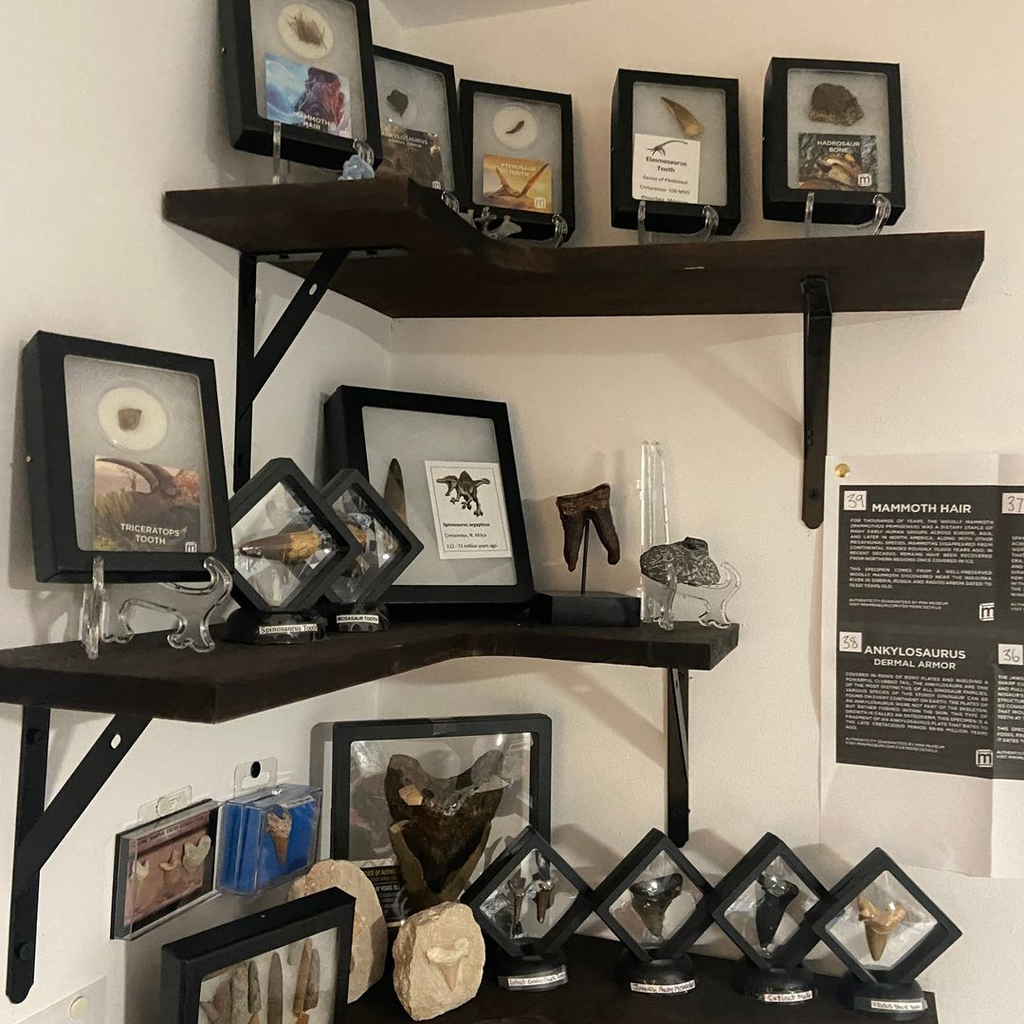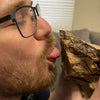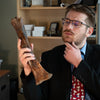How to Buy Dinosaur Fossils

A Tyrannosaurus rex skeleton cast at a Tucson-area trade show. (Source: Mini Museum)

In museums across the world you can go see dinosaur fossils, scattered bones reassembled into their original forms of a roaring Tyrannosaurus or a lumbering Sauropod. It’s one thing to see a dinosaur fossil, but it is quite another to hold one in your hand. Here are the best tips for purchasing a dinosaur fossil to add to your personal collection.

A beautiful Triceratops brown horn fossil in a personal home display. (Source: Mini Museum)

1. First things first, you have to know where to buy from. Dinosaur fossils can be sold at specialty stores or trade shows, usually close to the big dig sites in the United States, mostly in the Southwest.
If that's a bit of a trek for you, there are also many online vendors to choose from that sell dinosaur fossils. When purchasing online, it's important to ensure the seller is reliable and the artifacts are certified genuine. With auction sites like eBay and Etsy, it can be difficult to determine the legitimacy of the seller, so it's best to stick with specialist sites. You should always check to see if they have an about or authenticity page too. It's also good to see if they can share the area that the fossil came from.

A row of high quality Spinosaurus teeth for personal collectors. (Source: Mini Museum)
2. Once you have a seller you trust, the next question is what kind of dinosaur fossil you want, and what you want to pay for it. Chances are you don’t have a spare 30 million in your monthly budget to buy a complete T-rex skull, but other specimens like teeth or fossil fragments are far more affordable, selling for twenty or thirty dollars. Dinosaur fossils are precious items, but there are new ones found every day by field paleontologists, meaning just about anyone can own a fossil.
So what kind of fossil do you want to own? Keep in mind fossils can come in many forms. A classic permineralized fossil is when minerals leach into an organism’s bones, replacing and preserving it with stone. A cast or mold retains the shape of the specimen, without actually preserving the form itself. A trace fossil may be a fossilized footprint, or some other mark left behind by the creature. There’s a lot of options to choose from.

3. You’ll also want to keep in mind the different eras that fossils can come from. If you’re interested in dinosaurs, you’re going to want to focus on the Triassic, Jurassic, and Cretaceous periods. Dinosaurs emerged during the Triassic, but didn't come to dominate until the Jurassic, after the end Triassic extinction event. At this time, from 200-150 Mya, dinosaurs ruled the land, seas, and air. All together, the age of dinosaurs is called the Mesozoic and any fossil from this period is a real treasure.

Carcharodontosaurus teeth that can be held in the palm of your hand. (Source: Mini Museum)
4. Most importantly is the question of the dinosaur itself. What dinosaur fossil do you want to own? Some specimens are rarer than others, and their costs are prohibitively expensive. If you're just starting out, a small tooth can be the perfect entry point. A dinosaur tooth is a distinctive and easily identifiable specimen that can be purchased without breaking the bank. A single carnivorous dinosaur like Spinosaurus could grow dozens of teeth throughout its life, leaving behind many specimens to be had today.
You should also think about what kind of dinosaur you want. Are you looking for an herbivore or a carnivore? What about a Triassic, Jurassic, or Cretaceous creature? There are many different types of dinosaurs to choose from: Triceratops, Tyrannosaurus Rex, Stegosaurus, Ankylosaurus, Spinosaurus, Raptors (Dromaeosaurids), Iguanodon, Pachycephalosaurus, Sauropods, and more. You could even look for other fossils from non-dinosaur creatures, like Mosasaurs, Plesiosaurs, or Megalodons.


5. Once you have your fossil, caring for the specimen is very important. A fossil has survived millions of years to the present moment, but can still be damaged by neglect. You want a nice spot for displaying, but not anywhere the fossil can be damaged. Keep the specimen dry and clean. Remember to handle gently. A display case or stand is the perfect way to show off your new treasure!
Before buying a dinosaur fossil, remember to think about what dinosaur you'd like to purchase and where you're buying it from. Check for fossils from trusted sources that can trace the fossil's origin. There are plenty of ways to start building up your collection of dinosaur fossils right now and before you know it, you could have your very own museum lining a bookshelf of your home!
Ready to start your dinosaur hunt? Check out some of these fossils and browse our entire fossil collection below!


Featured Product
Beatles Brick Cavern Club Vial Necklace
Cool Things!

Lyndon Johnson: Architect of the U.S. Space Program
The Space Race is an era etched in the mythos of the United States. The starting gun, fired October 4th, 1957, as the Soviet Union launched the first-ever artificial satellite into space, was quickly answered by President John F. Kennedy a month later. In a special session of Congress, he set forth the goal of landing a man on the moon before the decade was out. If Kennedy was Jason on this voyage to the stars, Vice President Lyndon B. Johnson was his Argus, constructing the means of transport long before this challenge was issued and long before his superior’s assassination tumbled the nation into darkness.

Scientists Film a Colossal Squid in its Natural Habitat!
One hundred years after its discovery, scientists have captured the elusive colossal squid on film in its natural habitat. The juvenile squid was found around 2,000 feet below the surface of the Atlantic Ocean near the South Sandwich Islands. Measuring about one foot long, it drifts through the sea with translucent skin, pearly eyes and colorful tentacles.

Archaeologists Discover Tomb of an Unknown Pharaoh!
Specimen Deep Dives

Returning to the Moon: The Apollo 14 Mission

The Secrets of the Space Shuttle: Learn about Mini Museum's Shuttle Tile Material!

Gondwana: When the Earth Was One
Long Form Articles

Can I Lick It? Yes You Can!
Have you ever been unable to tell if a fossil was really a fossil, but you were too embarrassed to admit it? Have you ever wanted to lick a fossil just because, but you didn’t want to risk judgment from your peers? Well, good news! You can kill two birds with one stone! Licking a fossil can actually help you determine if it’s the real deal or just another rock.

Is It Legal To Own a Meteorite: How to Start Your Outer Space Collection!
Meteorites are some of the rarest geological specimens to be found on Earth. Of course, since these stones are not of our world, purchasing them can sometimes be a confusing process. Is it legal to own a meteorite? In short, yes! Read on for help starting your cosmic collection!

Is It Legal To Own a Dinosaur Fossil? How to start your Dinosaur Collection!
So you want to start fossil collecting!? Amateur paleontology is a fascinating and fun hobby that can even nab you an award! Dinosaur bones are some of the most sought-after specimens in the world, so you may be wondering, is it even legal to own a dinosaur bone? In short, yes! Read on for more help starting your fossil collection!









